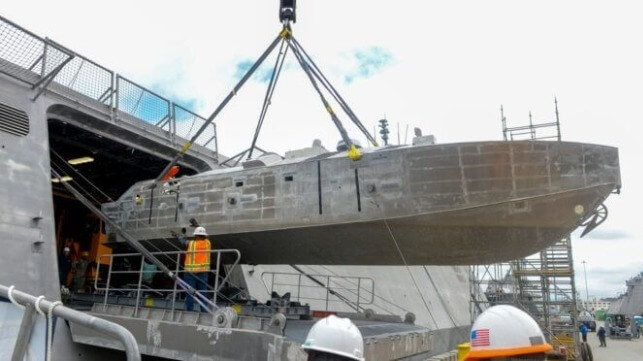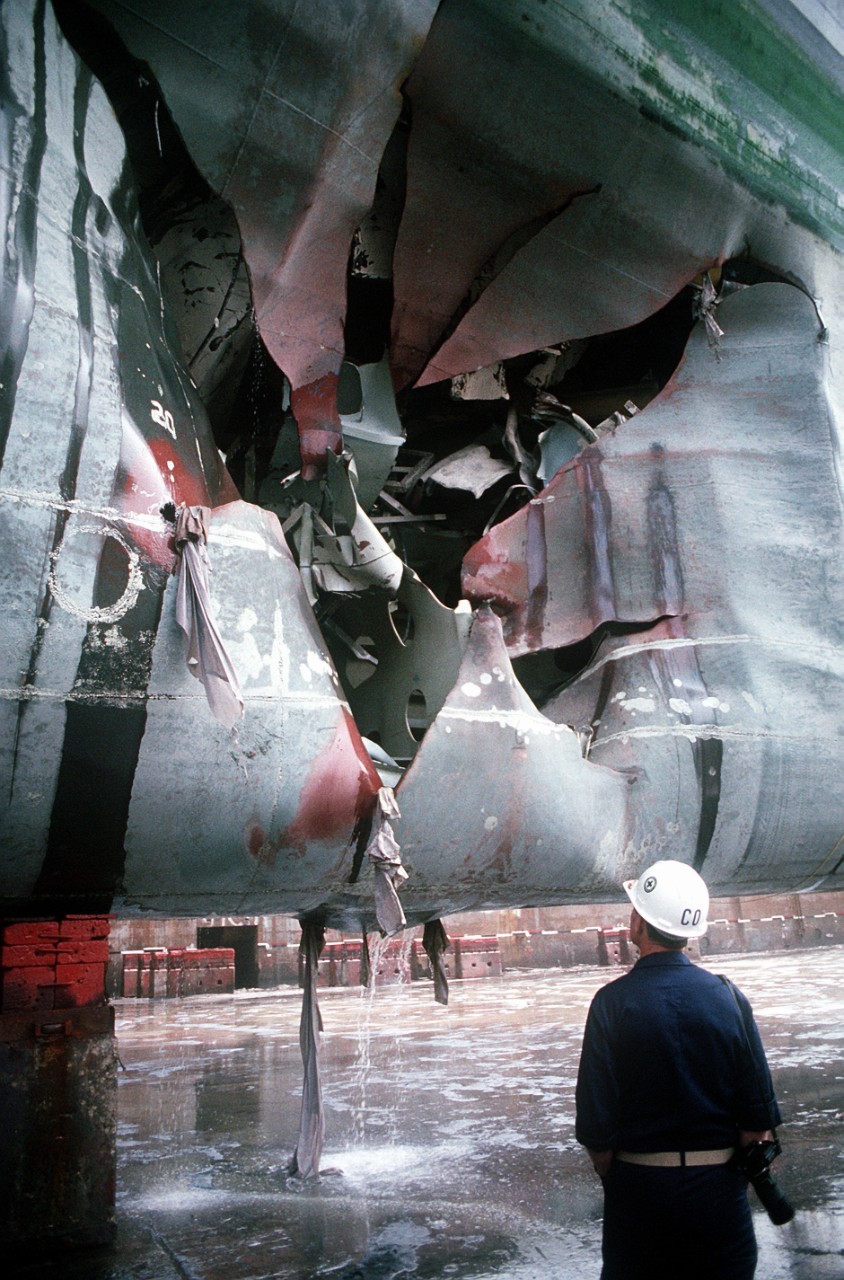The Indispensable Ingredient for Victory: Defeating Sea Mines

[By Capt. George Galdorisi]
At no time since the end of World War II have so many nations fielded blue water navies that have roamed the globe. Navies from Australia, China, Japan, Russia, the United Kingdom, and the United States have regional and worldwide commitments. Whether it is reinforcing or challenging rules-based order at sea, showing resolve to reassure allies and deter rivals, or exercising with other navies, these fleet also recognize that they must be prepared for high-end war at sea. Comparative naval advantage has returned as a critical unit of measure in great power competition.
But despite growing threats, navies have become accustomed to traversing the oceans and littorals with near impunity. This ability is now being increasingly jeopardized, and not necessarily by conventional high-end threats. For centuries, sea mines have presented an affordable and effective option in naval warfare. That threat is increasing today. The number of countries with mines, mining assets, mine manufacturing capabilities, and the intention to export mines has grown dramatically over the past several decades. More than fifty countries possess mines and mining capability. Of these, thirty countries have demonstrated an indigenous mine production capability and twenty have attempted to export these weapons. Additionally, non-state actors have used these cheap and plentiful weapons to hazard commercial vessels and disrupt commerce on the oceans.
When policymakers, military leaders, and analysts compare the qualities of various navies, they typically think in terms of numbers of ships, submarines, aircraft, and other conventional assets. However, considering the growing threat of sea mines worldwide, the capability to employ and defeat mines forms another core consideration in gauging the balance of naval advantage. Navies must consider how to field affordable and risk-worthy unmanned systems at scale to meet the mine threat.
A Centuries Old Challenge
Mine warfare is not new. Precursors to naval mines were first invented by innovators of Imperial China. The first plan for a sea mine in the West was drawn up by Ralph Rabbards, who presented his design to Queen Elizabeth I of England in 1574. Since the invention of the Bushnell Keg in 1776 (a watertight keg filled with gunpowder that was floated toward the enemy, detonated by a sparking mechanism if it struck a ship), mine warfare has been an important element of naval warfare.1 While the first attempt to deliver the Bushnell Keg from America’s first combat submarine, the Turtle, against a British warship in 1776 failed, subsequent attempts to employ these early mines were successful.2
Over 150 years ago, Admiral David Farragut became famous for “damning torpedoes” (which were actually mines) at the entrance to Mobile Bay during the Civil War.3 Indeed, in the early stages of the Civil War, Admiral Farragut wrote to Secretary of the Navy Gideon Welles about the sea mine threat posed by the Confederacy, stating, “I have always deemed it unworthy of a chivalrous nation, but it does not do to give your enemy such a decided superiority over you.” Farragut’s warning was eerily prescient. 4
The use of sea mines and countermeasures to these weapons have figured significantly in every major war and nearly every regional conflict in which the United States has been involved since the Revolutionary War. Indeed, the naval mine has been a mainstay of modern warfare. The North Sea Mine Barrage, a large minefield laid by the U.S. Navy and Royal Navy between Scotland and Norway during World War I, inhibited the movement of the German U-boat fleet. During World War I more than one thousand merchant ships and warships were lost because of the 230,000 mines used.5 NATO navies continue to clear these mines to this day.6
Mines released by U.S. Navy submarines and dropped by U.S. Army Air Force B-29 bombers in the Western Pacific during World War II sank hundreds of Japanese warships, merchant ships, and smaller vessels. During World War II 2,665 ships were lost or damaged by 100,000 offensive mines.7
In Korea during the early 1950s, the Soviets provided North Korea with thousands of sea mines. These were used to defend key harbors and multiple U.S. warships struck mines. During the Vietnam War, over 300,000 American naval mines were used. In 1972 Haiphong Harbor was seeded with 11,000 destructor mines and was shut down completely for months, and it took years to clear out all the American mines.8
In the past several decades, rogue states have indiscriminately employed sea mines. Libya used mines to disrupt commerce in the Gulf of Suez and the Strait of Bab el Mandeb. In the 1980s Iran laid mines to hazard military and commercial traffic in the Arabian Gulf and Gulf of Oman, leading to the devastating mine strike against USS Samuel B. Roberts (FFG 58). During Operation Desert Storm in 1990-1991, the threat of mines precluded the effective use of the Navy and Marine Corps expeditionary task force off Kuwait and hazarded all U.S. and coalition forces operating in the Arabian Gulf. Indeed, Operation Desert Storm highlighted the importance of mine warfare with the heavy damage dealt to USS Princeton (CG 59) and USS Tripoli (LPH 10). The U.S. Navy has an abundant history of employing mines and striking them, but it remains unclear what the U.S. Navy’s mine strategy is for modern naval warfare.

Captain Bruce McEwen, commanding officer of amphibious assault ship USS Tripoli (LPH-10), inspects damage to the vessel inflicted by an Iraqi mine that the ship struck while serving as a mine clearing platform during Operation Desert Storm, February 18, 1991. (Photo via U.S. National Archives)
Today’s Ongoing Mine Challenge
Mine warfare remains a critical element of naval capability. In terms of availability, variety, affordability, ease of deployment, and potential impact on naval operations, mines are some of the most attractive weapons available.
Sea mines are hard to find, difficult to neutralize, and can present a deadly hazard to any vessel—especially those ships specifically designed to hunt them. They can also heavily shape behavior and weigh on the operational calculus of commanders, making them a source of potent psychological effects in the battlespace.
Great power rivals are likely to employ mines in any conflict with the United States. Scott Truver highlighted the danger posed by China’s mine warfare capabilities, as well as those of other potentially hostile nations:
“The mine warfare experiences of America and other nations are not lost on the People’s Liberation Army Navy (PLAN). Chinese naval analysts and historians understand the asymmetric potential for mine warfare to baffle the enemy, and thus achieve exceptional combat results.’ Mines provide what some have described as affordable security via asymmetric means.”9
Seth Cropsey echoed similar challenges and highlighted the mining capabilities China and Russia would bring to the fight. He focused primarily on the threat from China, noting:
“One of the top global mine threats comes from China. It has been estimated that Beijing has as many as 100,000 such weapons. Those range from the old-fashioned moored contact mine to include mines that have rocket-propelled weapons and target detection systems. In the event of a conflict with China, the United States is unlikely to approach warfare from the land. That leaves us with the seas as the place where conflict is most likely to play out.
Beijing would likely concentrate on creating choke points in areas such as the archipelagos that separate East Asia from the Middle East and the South China Sea. That means that sea control and navigating around China’s anti-access and area denial capabilities will be crucial. It’s reasonable to expect that the Chinese would use mines there, and reasonable to expect that they would use mines if they decided to use force against Taiwan. Moving through those straits is crucial and being able to clear them of mines is equally important.”10
The danger of naval mines being employed short of major war is acute in the Middle East. In October 2020, a Maltese-flagged tanker was damaged by a mine while taking on crude oil the Yemeni port of Bir Ali. MV Syra reportedly suffered significant damage, resulting in an oil spill.11 Shortly after this event, in November 2020, a mine in the Red Sea exploded and damaged a Greek oil tanker.12 In December 2020, a Singapore-flagged tanker berthed at the Saudi Arabian port city of Jeddah was damaged by a mine, with Houthi militia from Yemen strongly linked to this attack.13 In January 2021, an oil tanker off the coast of Iraq discovered a mine attached to its hull.14 Regional navies, assisted by U.S. and U.K. navies, have stepped up mine countermeasures exercises in the Arabian Gulf.15 Most recently, France, the United Kingdom, and the United States conducted the Artemis Trident MCM Exercise in Arabian Gulf.16
As part of the 2022 Russian invasion of Ukraine, Russia mined the waters off the Crimean Peninsula. Some of those mines either broke loose or were cut loose and drifted into shipping lanes used by Ukrainian and NATO ships.17 Russia has continued to use sea mines extensively during the conflict in Ukraine. One of the most prominent examples involved Russian forces laying mines along the Dnieper River to the north of Kherson city to make it harder for the Ukrainians to cross.18
Other incidents have included Russian drifting mines that have been found along the coasts of Turkey and Romania, as well as elsewhere in the Black Sea. An Estonian cargo ship in the Black Sea was sunk by a Russian mine during this war.19 More recently, in February 2023, Turkish media claimed that a drifting sea mine exploded near Agva on the Black Sea coast.20
The ability of the U.S. Navy to deal with the growing threat of sea mines is not getting better, it is getting worse. The platforms that embody the U.S. Navy’s primary mine countermeasures (MCM) capability—the MH-53E AMCM aircraft and the Avenger-class minesweeper—are scheduled to retire in the next few years, which will leave the totality of the Navy’s MCM capability in the discrete number of Littoral Combat Ships (LCS) to be outfitted with the Mine Countermeasures mission package, which has suffered multiple delays during testing and development.
This is not the MCM capability needed by a global navy facing a pervasive mine threat. Nor is it a solution that eliminates the extreme danger to Sailors who are forced to work in a minefield to accomplish their mission, especially when the minefield is overlayed with the advanced anti-ship and anti-air capabilities of a great power adversary. Fortunately, technology has advanced to the point that with the proper commitment the Navy can conduct MCM remotely by leveraging unmanned systems and take the Sailor out of the minefield.
Leveraging Unmanned Technologies to Defeat Deadly Sea Mines
For all navies, there is only one way to completely take the Sailor out of the minefield and that is to leverage unmanned technologies to hunt and destroy mines from a distance. While this principle is readily acknowledged, it is not a lack of need that has impeded the Navy’s efforts, but rather technological maturity. In the past, unmanned vehicle technologies were not mature enough to take on the complex task of mine hunting. But today, they are now capable enough. These capabilities are no longer based on concepts or early prototypes. Rather, every necessary component has been in the water and tested in operational environments.
The following proposal is based on three subcomponent candidates that can deliver a single-sortie, autonomous mine countermeasures solution with autonomous target recognition. This design can also flexibly accommodate various towed sonars and remotely operated vehicles (ROVs).
The MARTAC Devil Ray T38 is intended as the autonomous platform for the package, and will host a communications and data transmission hub, in addition to above-water and underwater sensors.
The ThayerMahan Sea Scout Subsea Imaging System is specifically designed for missions such as mine hunting. The Sea Scout system is based on the in-production COTS Kraken Robotics Katfish-180 tow-body mounted synthetic aperture sonar. The system is designed to search for mine-like objects and is integrated by ThayerMahan’s remote operations and communications system.
The Pluto Gigas is an existing, standalone, third generation ROV with several systems deployed globally and with over 3,000 mines destroyed. The Pluto Gigas deploys an acoustically armed and detonated countermine charge that is low-cost both in production and in logistics and sustainment. Several charges can be loaded onto the T38 to enable single-sortie field clearance.
These three components can combine to deliver an effective mine hunting solution. The driving principle of this solution is to incorporate mature hardware that will minimize risk to the host platform during execution of the MCM mission. To that end, the weight and outside dimensions of the mission package are within a few inches of the dimensions of a common 11-meter RHIB. Launch and recovery should be easily accomplished using standard naval small craft handling procedures for the host vessel.
While this MCM solution is component agnostic, the leading commercial-off-the-shelf candidates for the initial solution were chosen based on their technical maturity, as well as their current use by various navies. Leveraging these commercial-off-the-shelf (COTS) systems will enable this MCM solution to move forward at an accelerated pace to speedily deliver a fleet capability in the near term.
The Need to Take Action Today to Address the MCM Challenge
Because ships and Sailors operate daily in harm’s way, the U.S. Navy and Marine Corps—and by extension other allied navies—would be well-served to accelerate their efforts to deal with deadly sea mines. The essential components for such a system exist today, and a robust COTS MCM solution can reach fruition in the near-term.
While programs of record are developing next-generation technology, navies should invest in parallel-path solutions that leverage mature subsystems that are ready to provide capability today. It is time to put a speedy solution in the hands of Sailors.
To achieve victory, navies must get to the fight in the face of anti-access area denial capabilities of adversaries. Given the low cost, ease of deployment, and increasing proliferation of naval mines, the ability to find and clear these deadly mines makes for a major pacing challenge for navies. Developing and fielding mine countermeasures capabilities, overlooked for too long, should be a first order priority for navies today.
Captain George Galdorisi is a career naval aviator and national security professional. His 30-year career as a naval aviator culminated in 14 years of consecutive service as executive officer, commanding officer, commodore, and chief of staff. He enjoys writing, especially speculative fiction about the future of warfare. He is the author of 18 books, including four consecutive New York Times bestsellers. His latest book, published by the U.S. Naval Institute, is Algorithms of Armageddon: The Impact of Artificial Intelligence on Future Wars.
This article appears courtesy of CIMSEC and may be found in its original form here.
References
[1] Tyler Rogoway, “The Revolutionary War Gave Birth to the Age of Naval Mine Warfare,” The War Zone, July 4, 2016, accessed at: https://www.thedrive.com/the-war-zone/4256/the-revolutionary-war-gave-birth-to-the-age-of-naval-mine-warfare.
[2] Christopher Hevey and Anthony Pollman, “Reimagine Offensive Mining, U.S. Naval Institute Proceedings, January 2021.
[3] Farragut’s boldness is especially striking because in 1862 a Confederate mine sank USS Cairo in the Yazoo River.
[4] U.S. Navy Fact File, “U.S. Navy Mines,” accessed at: https://www.navy.mil/Resources/Fact-Files/Display-FactFiles/Article/2167942/us-navy-mines/.
[5] See, for example, Paul Ahn, “A Tale of Two Straits,” U.S. Naval Institute Naval History Magazine, December 2020 for a concise history of naval mine warfare.
[6] “NATO Forces Clear Mines off Port of Dieppe,” The Maritime Executive, April 9, 2020, accessed at: https://www.maritime-executive.com/editorials/royal-navy-clears-mines-off-port-of-dieppe.
[7] US Navy Fact File, “US Navy Mines,” accessed at https://www.navy.mil/navydata/fact_display.asp?cid=2100&tid=1200&ct=2).
[8] “Surface Forces: Mines Revisited,” Strategy Page, March 13, 2020, accessed at: https://www.strategypage.com/htmw/htsurf/articles/20200313.aspx
[9] Scott Truver, “Taking Mines Seriously: Mine Warfare in China’s Near Seas,” Naval War College Review, Spring 2012, accessed at:
https://digital-commons.usnwc.edu/cgi/viewcontent.cgi?referer=&httpsredir=1&article=1429&context=nwc-review.
[10] Yasmin Tadjdeh, “Navy Invests in New Mine Warfare Technology,” National Defense Magazine (online), April 6, 2020, accessed at: https://www.nationaldefensemagazine.org/articles/2020/4/6/navy-invests-in-new-mine-warfare-technology.
[11] Edward Lundquist, “Tanker Loading Crude Damaged by Floating Mine in Yemen,” Seapower, October 9, 2020, accessed at: https://seapowermagazine.org/tanker-loading-crude-damaged-by-floating-mine-in-yemen/.
[12] Ryan White, “Greek-Operated Tanker Damaged by Mine at Saudi Terminal,” Naval News, November 25, 2020, accessed at: https://navalnews.net/greek-operated-tanker-damaged-by-mine-at-saudi-terminal/.
[13] Sam Chambers, “Hafnia Tanker at Jeddah Becomes Latest Mine Victim,” Splash 247.com, December 14, 2020, accessed at: https://splash247.com/hafnia-tanker-at-jeddah-becomes-latest-mine-victim/.
[14] “Oil Tanker Near Iraq Finds Mine on Hull as Gulf Risks Mount,” Newsmax, January 4, 2021, accessed at: https://www.newsmax.com/newsfront/cos-exe-gen-gov/2021/01/01/id/1003892/.
[15] “Saudi, UK, U.S. Naval Forces Conduct Mine Countermeasures Training,” Defense-Aerospace, November 29, 2020, accessed at: https://www.defense-aerospace.com/articles-view/release/3/214552/saudi%2C-uk%2C-u.s.-naval-forces-conduct-mine-countermeasures-training.html.
[16] Naval News Staff, “U.S. France and UK Complete Artemis Trident MCM Exercise in Gulf,” Naval News, April 13, 2023.
[17] “Weapons: Naval Mines in The Black Sea,” Strategy Page, February 2, 2023, accessed at: https://www.strategypage.com/htmw/htweap/articles/20230202.aspx.
[18] Gerrard Kaonga, “Russia Mines River as Soldiers Prepare Kherson Retreat: Kyiv,” Newsweek, October 25, 2002.
[19] Scott Savitz, “The Drifting Menace,” Real Clear Defense, (undated), accessed at: https://www.realcleardefense.com/articles/2022/11/16/the_drifting_menace_865111.html.
[20] Tayfun Ozberk, “Sea Mine Explodes on Turkey’s Black Sea Coast,” Naval News, February 14, 2023.
The opinions expressed herein are the author's and not necessarily those of The Maritime Executive.




